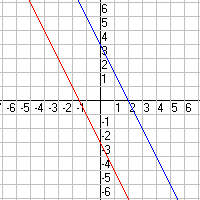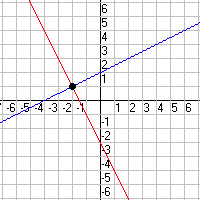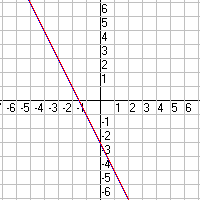Solving Systems of Linear Equations
A system of linear equations is just a set of two or more linear equations.
In two variables , the graph of a system of two equations is a pair of lines in the plane.
There are three possibilities:
- The lines intersect at zero points. (The lines are parallel.)
- The lines intersect at exactly one point. (Most cases.)
- The lines intersect at infinitely many points. (The two equations represent the same line.)
Zero solutions:

One solution:

Infinitely many solutions:

There are a few different methods of solving systems of linear equations:
- The Graphing Method . This is useful when you just need a rough answer, or you're pretty sure the intersection happens at integer coordinates. Just graph the two lines, and see where they intersect!
- The Substitution Method . First, solve one linear equation for in terms of . Then substitute that expression for in the other linear equation. You'll get an equation in . Solve this, and you have the -coordinate of the intersection. Then plug in to either equation to find the corresponding -coordinate. (If it's easier, you can start by solving an equation for in terms of , also – same difference!)
- The Linear Combination Method , aka The Addition Method , aka The Elimination Method. Add (or subtract) a multiple of one equation to (or from) the other equation, in such a way that either the -terms or the -terms cancel out. Then solve for (or , whichever's left) and substitute back to get the other coordinate.
- The Matrix Method . This is really just the Linear Combination method, made simpler by shorthand notation.
See the second graph above. The solution is where the two lines intersect, the point .
Example 1:
Solve the system
Solve the second equation for .
Substitute for in the first equation and solve for .
Substitute for in and solve for .
The solution is .
Example 2:
Solve the system
Multiply the first equation by and add the result to the second equation.
Solve for .
Substitute for in either of the original equations and solve for .
The solution is .



